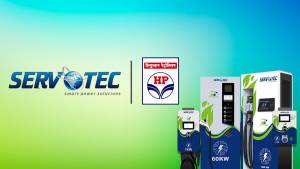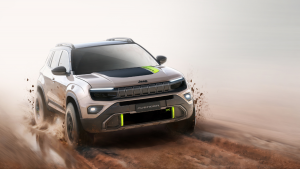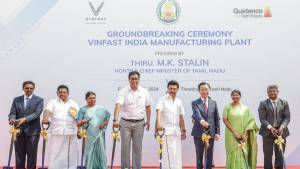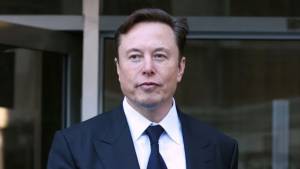Electric vehicles - and driving with instant torque and rapid acceleration
The interest in electric vehicles or EVs is growing and one is often asked, "How different is the EV driving experience?" Well though there are some similarities, there are also several huge disparities. In this series of stories, we will highlight how driving an electric vehicle, is quite unlike a conventional car.
 Electric vehicles develop instant torque and therefore have speedy acceleration.
Electric vehicles develop instant torque and therefore have speedy acceleration.
One of the major differences between driving a conventional fuel powered car and an electric one, is the speedy acceleration due to the instant torque. As mentioned earlier in this series of stories, an electric motor does not need to burn fuel like an internal combustion engine and generate power via the combustion process. Instead it draws its power from batteries, and thus electric motors can provide their max torque and power from zero RPM (revolutions per minute).
 The Tesla gets to 100 kph faster than many supercars and is presently the fastest production sedan on our planet!
The Tesla gets to 100 kph faster than many supercars and is presently the fastest production sedan on our planet!
What this means is that when you press the accelerator pedal in an electric vehicle there is an immediate surge of power due to the instantaneous torque delivery. Yes, EVs are quicker off the block than even some sports cars! One of the fastest production supercars, the Bugatti Veyron Super Sport that develops 1184 bhp, takes about 2.5 seconds to get from 0 to 100 kph. Compare this with the electrically powered four door sedan, the Tesla Model S P100D, which requires just 2.4 seconds to reach 100! Yes, this electrically powered family sedan not only gets to the 100 mark before one of the world's fastest petrol powered supercars, but it's presently also the fastest production sedan on our planet!
 The drivability in an EV is also better due to the instant torque delivered across a wide rev range.
The drivability in an EV is also better due to the instant torque delivered across a wide rev range.
The instant torque delivery means that when you compare the acceleration time of the electric and IC (internal combustion) engine powered versions of even the same model, the EV is usually faster. For example the 1.5 litre diesel driven Tata Nexon gets from 0 to 100 kph in about 13.5 seconds, whereas the Nexon EV takes only 9.9 seconds! This is the benefit of max torque from zero rpm.

As a matter of fact, all manufacturers of IC cars also go to great lengths to ensure that their engines develop max torque at low rpms, as this gives quicker response and better acceleration. But as there is no way they can avoid the internal combustion process of the engine burning a mixture of air and fuel with compression and ignition via pistons and spark plugs, they just cannot match or beat a battery powered electric motor, which generates its peak torque from zero rpm

Another advantage of this instant torque is better drivability. Electric motors don't have a limited rev range like IC engines and some of them can even rev up to 20,000 rpm! And as they are able to consistently produce and provide torque across their wide rev range, it means when you want to get a move on, you just need to push the pedal to obtain instant response and acceleration. Yes, unlike an IC car there is no down shifting or waiting for the engine to build revs and the vehicle to gather speed before overtaking. In an EV you ask, and you get.
 The availability of peak torque at zero rpm, also makes off - roading easier.
The availability of peak torque at zero rpm, also makes off - roading easier.
This instant torque not only provides better drivability, but it also makes off - roading easier. Since peak torque is available even from a dead stop, you don't have to build momentum before traversing loose surfaces or climbing slopes. In fact you could stop midway and start and go. There is also no need to roll back and build speed and attack slopes and neither do you have to slip the clutch to build revs and start. It's simply just press and go. And as electric motors can rotate up to 20,000 RPM, there is no fear of redlining or damaging them either.

But there is one thing you need to be careful about. As driving an EV is comparatively simpler and requires a driver to do fewer things, there is a tendency to over speed and drive faster than one normally would. So if you are driving an EV for the first time, I strongly suggest you exercise extreme caution until you get completely comfortable with the instant acceleration and buildup of speed and learn how to handle it.
 First time EV drivers should exercise extreme caution until they get used to the instant acceleration.
First time EV drivers should exercise extreme caution until they get used to the instant acceleration.
Also see:
Electric vehicles - and driving with only one pedal
Electric vehicles and driving with "e-silence"
Starts Rs 12 Crore
7993cc
Automatic
1001
1250
4.02 Kmpl
Starts Rs 6.95 Lakhs
1497cc
Automatic
110
260
21.5 Kmpl
-NA-
-NA-
503
660
-NA-
Related Stories
Top Stories
Latest Videos
Most Popular
- Upcoming Mahindra XUV 3XO: All you need to know
- Budget Sportbike Showdown: Kawasaki Ninja 500 vs Aprilia RS 457 vs Yamaha YZF-R3
- New Suzuki Swift spotted testing
- Nissan Magnite EZ-Shift review - is the AMT any good?
- 2024 Hyundai Creta vs Toyota Urban Cruiser Hyryder vs Skoda Kushaq comparison review - the hype is real?














